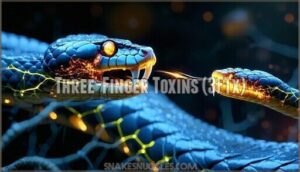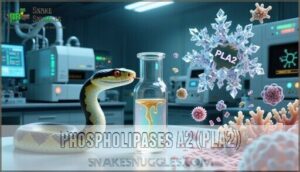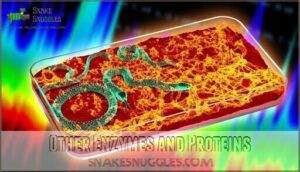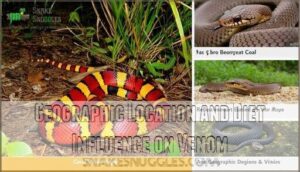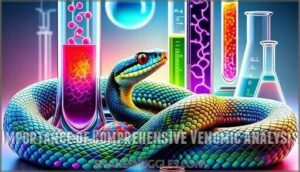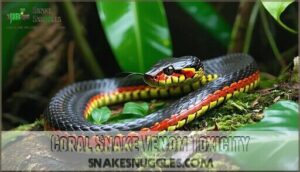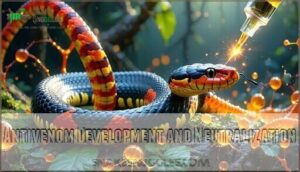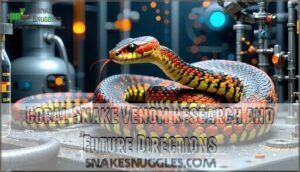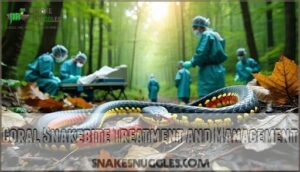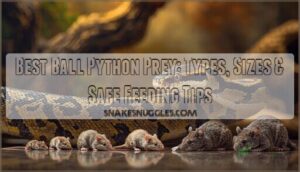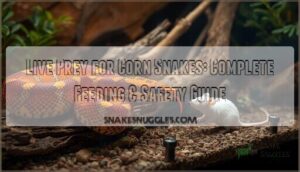This site is supported by our readers. We may earn a commission, at no cost to you, if you purchase through links.

The venom contains primarily three-finger toxins (3FTx) and phospholipases A2 (PLA2), making up 86% of toxic components across 15+ toxin families.
These proteins work like a tag team – 3FTx blocks your nerve signals while PLA2 destroys cell membranes.
What’s fascinating is how dramatically the composition varies by geography: northern species pack more PLA2 (45-72%), while southern populations favor 3FTx dominance (48-95%).
This variation isn’t random – it’s shaped by diet, evolution, and regional isolation over millions of years, creating unique biochemical fingerprints that challenge antivenom development.
Table Of Contents
- Key Takeaways
- Coral Snake Venom Composition
- Venom Variation Within Species
- Venomics and Venom Analysis
- Micrurus Helleri and M. Lemniscatus Venom Analysis
- Coral Snake Venom Toxicity
- Antivenom Development and Neutralization
- Coral Snake Venom Research and Future Directions
- Coral Snakebite Treatment and Management
- Coral Snake Venom and Human Health
- Advances in Coral Snake Venom Analysis
- Frequently Asked Questions (FAQs)
- Do Colombian coral snakes have venom?
- Which coral snakes have a ‘pla2-rich’ venom?
- Do Brazilian coral snakes have venom?
- Which venom is most southerly coral snake?
- Do Coral Snake Venoms cause myonecrosis?
- Is a coral snake bite 100% fatal?
- Why was coral snake antivenom discontinued?
- What is the chemical composition of snake venom?
- What type of venom does the coral snake have?
- What are the components of coral snake venom?
- Conclusion
Key Takeaways
- You’ll face nature’s deadliest neurotoxic cocktail – coral snake venom contains 86% toxic components from 15+ toxin families, with three-finger toxins blocking nerve signals while phospholipases A2 destroy cell membranes
- Geographic location dramatically changes venom potency – northern coral snake species pack 45-72% PLA2 enzymes, while southern populations favor 48-95% three-finger toxin dominance, creating unique biochemical fingerprints
- Venom variation complicates life-saving treatment – dramatic composition differences between species and regions mean antivenoms show reduced effectiveness against unfamiliar venom variants, making geographic-specific protocols essential
- Advanced research reveals hidden medical treasures – scientists use cutting-edge techniques like phage display and mass spectrometry to unlock therapeutic potential in coral snake toxins for pain management, anti-inflammatory treatments, and cancer therapy
Coral Snake Venom Composition
You’ll discover that coral snake venom contains a deadly cocktail dominated by three-finger toxins and phospholipases A2, making up roughly 86% of the toxic components.
These venoms pack more complexity than scientists originally thought, with at least 15 different toxin families working together to create one of nature’s most efficient neurotoxic weapons.
Three-Finger Toxins (3FTx)
When you encounter coral snake venom, you’re facing nature’s molecular assassins called three-finger toxins (3FTx).
Nature’s ultimate biochemical assassins strike with molecular precision, targeting your nervous system through deadly three-finger toxins
These 3FTx mechanisms target your nervous system like precision weapons, blocking nerve signals and causing paralysis.
Scientists have discovered incredible 3FTx diversity across coral snake species, with each variant evolved through millions of years of 3FTx evolution to maximize hunting efficiency against specific prey, utilizing precision weapons.
Phospholipases A2 (PLA2)
After exploring three-finger toxins, you’ll encounter phospholipases A2 (PLA2)—coral snake venom’s cell membrane destroyers.
These enzymes showcase remarkable PLA2 structure diversity and PLA2 activity patterns.
PLA2 isoforms vary between species, reflecting PLA2 evolution pressures.
Understanding phospholipase A2 mechanisms helps develop PLA2 inhibition strategies.
Venom analysis reveals these phospholipases dominate many coral snake venom profiles, making venom composition research essential.
Other Enzymes and Proteins
Beyond phospholipases, you’ll find coral snake venom contains a fascinating arsenal of secondary proteins. L-amino acid oxidase generates toxic hydrogen peroxide, while metalloproteinases break down tissue matrices. C-type lectins disrupt blood clotting, and serine proteinases affect coagulation pathways.
This complex venom composition showcases nature’s biochemical warfare. Studying these proteomes requires advanced mass spectrometry techniques.
- L-Amino Acid Oxidase – produces hydrogen peroxide that damages cells
- Metalloproteinases – digest tissue structures and blood vessel walls
- C-Type Lectins – interfere with blood clotting mechanisms
- Serine Proteinases – alter blood coagulation and fibrinolysis processes
Geographic Variation in Venom Composition
Coral snake venom composition isn’t uniform across regions.
Geographic variation creates distinct toxin profiles through dietary influence and phylogeographic distribution patterns.
This interspecific variability reflects coevolutionary arms races between predators and prey:
- Northern species show higher PLA2 concentrations (45-72% of total proteins)
- Southern populations display 3FTx dominance (48-95% abundance)
- Regional isolation drives unique toxin dichotomy patterns within Micrurus species.
Notably, unlike rattlesnakes, coral snake venom shows remarkable venom uniformity.
Evolutionary History of Venom Composition
Over millions of years, venom evolution has crafted coral snake toxins through adaptive evolution and selective pressures.
Nature’s deadliest arsenal evolved through relentless molecular warfare spanning millions of years
Nature’s deadliest cocktails evolved through millions of years of adaptive pressure and selective evolution.
Gene duplication events create toxin divergence, while dietary influence drives coevolutionary arms races with prey.
Phylogenetic analysis reveals this molecular clock ticking through species diversification, showing how venoms adapt to hunting strategies and environmental challenges across different coral snake lineages.
Venom Variation Within Species
You’ll discover that even within the same coral snake species, venom composition can vary dramatically based on where the snake lives and what it eats.
These variations aren’t just scientific curiosities—they can mean the difference between life and death regarding the choice of antivenom treatment.
Micrurus Helleri and M. Lemniscatus Venom Comparison
When comparing Micrurus helleri and Micrurus lemniscatus venom composition, you’ll discover a fascinating toxin dichotomy.
M. helleri contains 72% PLA2, creating dramatic proteomic differences from other coral snake venoms.
Both species show lethality variance despite similar geographic influence and dietary impact.
This venom analysis reveals how coral snake venom complexity shapes antivenom development strategies.
Geographic Location and Diet Influence on Venom
You’ll find that geographic variation shapes coral snake venom like a master chef adapts recipes to local ingredients.
Dietary Venom Variation occurs when snakes encounter different prey species across regions, creating Geographic Venom Profiles through evolutionary pressure.
This Venom Adaptation drives Interspecific Venom Variability, establishing Venom Evolutionary Arms races between predators and prey that continuously refine coral snake venom composition and potency.
Clinical Implications of Venom Variation
Venom variation creates a clinical minefield where geographic differences dramatically impact patient care.
Understanding these variations helps you navigate treatment challenges more effectively.
- Envenomation Severity: Symptoms vary wildly between geographic regions due to coral snake venom composition differences
- Treatment Efficacy: Antivenoms show reduced effectiveness against unfamiliar venom variants from different locations
- Diagnostic Challenges: Clinical presentations don’t always match textbook descriptions when venom variation occurs
- Management Strategies: Geographic-specific protocols improve patient outcomes and reduce complications substantially.
This is similar to how timber rattlesnakes exhibit regional venom variations.
Importance of Comprehensive Venomic Analysis
Three key approaches reveal coral snake venom’s mysteries through in-depth venomics research.
Proteomic analysis and transcriptomic analysis reveal toxin identification patterns that boost antivenom efficacy.
Understanding venom composition provides evolutionary insights with clinical relevance and therapeutic potential.
| Analysis Method | Key Benefits |
|---|---|
| Mass Spectrometry | Identifies protein families accurately |
| Chromatography | Separates venom components effectively |
| Transcriptomics | Maps toxin gene expression patterns |
| Proteomics | Quantifies actual venom proteins present |
Venomics and Venom Analysis
You’ll discover how scientists use advanced techniques like HPLC and mass spectrometry to decode coral snake venom’s molecular secrets.
These powerful analytical methods reveal the exact proteins and toxins that make these beautiful serpents so deadly.
Techniques Used in Venomics
Modern venomics reveals coral snake venom’s secrets through sophisticated analytical methods.
Scientists use powerful techniques to decode these complex molecular cocktails. Proteomic analysis helps understand venom toxicity and effects.
Key venomics techniques include:
- RP-HPLC separation: Sorts venom proteins by their water-loving or water-hating properties
- Mass spectrometry identification: Pinpoints exact molecular weights and structures like a chemical fingerprint
- Bioinformatic tools: Analyze transcriptomic data to reveal gene expression patterns in venom glands
Proteomic Analysis of Coral Snake Venom
How do scientists crack the code of coral snake venom?
Through proteomic analysis, researchers identify and quantify venom proteins using advanced techniques like mass spectrometry.
This process reveals three-finger toxins and phospholipases A2 that dominate coral snake venom composition.
Venom protein identification helps scientists discover novel toxins and understand post-translational modifications.
These proteomic database curation efforts support antivenom development by mapping each deadly component.
Researchers can find products for this analysis.
Comparative Venomics and Evolutionary Trends
Exploring venom evolution across Micrurus species reveals fascinating species divergence patterns shaped by selective pressure.
Dietary influence drives toxin dichotomy – some species favor PLA2 dominance while others emphasize 3FTx expression.
Transcriptomic analysis shows positive selection events following speciation, creating distinct venom composition profiles that reflect coevolutionary arms races with prey species.
Venomic Analysis for Antivenom Development
Understanding how venom variability affects antivenom development requires sophisticated proteomic analysis.
When you’re developing life-saving treatments, venom composition data guides neutralization strategies.
Here’s why toxin identification matters for antivenom efficacy:
- You’ll identify which coral snake venom proteins cause the most damage
- You can target specific toxins that current antivenoms miss
- You’ll overcome proteomic limitations through better venom analysis
- You save lives by creating more effective treatments
Micrurus Helleri and M. Lemniscatus Venom Analysis
When you examine Microrus helleri and M. lemniscatus venoms, you’ll find fascinating differences in their toxic cocktails that could revolutionize medicine.
These two coral snake species pack venoms with distinct three-finger toxin and phospholipase A2 ratios, plus surprising bradykinin inhibitor peptides that show promising anti-inflammatory effects.
3FTx and PLA2 Content in Venom
You’ll discover that Microrus helleri displays a fascinating toxin dichotomy with PLA2dominant phenotype comprising 72% of its coral snake venom.
Meanwhile, M. mipartitus showcases contrasting venom dominance where threefinger toxin reaches 63%.
These opposing expression patterns highlight how 3FTx function and PLA2 activity create distinct venom composition profiles among species.
Presence of Bradykinin Inhibitor Peptide
Often detected in Microrus helleri venom analysis, bradykinin inhibitor peptides block bradykinin’s inflammatory effects through targeted receptor antagonism.
These venom peptides show therapeutic potential for pain management and anti-inflammatory action.
Your venom biochemistry reveals nature’s paradox: deadly compounds offering drug delivery innovations. Peptide synthesis mimicking these molecules could revolutionize treatment approaches, transforming venom composition from threat to medical breakthrough.
Anti-Inflammatory Properties of Venom
Coral snake venom contains bradykinin inhibitor peptides that block inflammatory responses in your body.
These compounds show remarkable antiinflammatory properties by preventing bradykinin from triggering pain and swelling.
Scientists see huge therapeutic potential in these peptides for pain management and drug delivery systems.
The phospholipases work alongside these inhibitors, creating unexpected healing possibilities from deadly venom.
Potential Therapeutic Applications
Nature’s pharmacy might surprise you.
Coral snake venom proteins show promise for pain management and drug delivery systems.
These phospholipases and anti-inflammatory compounds could revolutionize cancer therapy through targeted peptide design.
Scientists study venom proteins as potential anticancer agents, transforming deadly toxins into life-saving therapeutic applications.
Venom composition varies depending on the species.
Death’s recipe becomes medicine’s blueprint.
Coral Snake Venom Toxicity
When you encounter coral snake venom, you’re facing a biochemical weapon that targets your nervous system with deadly precision.
The venom’s lethality varies dramatically between species, with M. medemi showing the highest toxicity at just 8.79 µg per mouse.
While factors like geographic location and individual health can substantially influence how severe your envenomation becomes, making each case uniquely dangerous due to the complexity of the venom’s interaction with the human body, and the potential for deadly precision in its effects.
Neurotoxicity and Myotoxicity
When you’re dealing with coral snake venom, you’ll face a dangerous double threat that targets your body’s most essential systems.
The venom composition creates devastating neurotoxicity and myotoxicity through specialized toxins that disrupt normal cellular function.
Here’s what coral snake venom toxins do to your system:
- Paralysis Mechanisms: Three-finger toxins block nerve signals, preventing muscle contractions
- Tissue Degradation: PLA2 enzymes break down cell membranes and cause widespread damage
- Cytotoxic Components: Multiple proteins work together to destroy healthy tissue cells
- Envenomation Effects: Progressive weakness spreads from bite site throughout your body
Clinical Management requires immediate antivenom administration to counteract these devastating effects.
Inflammation and Tissue Damage
When phospholipases A2 (PLA2) break down your cell membranes, they trigger inflammatory responses that cause edema formation and cellular necrosis.
These PLA2 mechanisms trigger cytokine release, activating pain pathways while destroying tissue.
You’ll see swelling, redness, and myotoxicity as these enzymes systematically damage cells, creating lasting tissue damage that extends far beyond the initial bite site.
Lethality of Venom and LD50
You’ll discover that coral snake venom toxicity varies dramatically between species.
LD50 values reveal this deadly truth – some pack lethal punches while others deliver gentler warnings.
Here’s what determines venom lethality:
- Eastern coral snakes show LD50 values of 0.23-0.29mg/kg in mice
- Central American species exhibit 0.3mg/kg (IV) toxicity levels
- Human lethal dose averages just 4-5mg of venom
- Large specimens yield up to 28mg – seven fatal doses
- Cytotoxicity effects vary substantially across geographic regions
This venom potency directly impacts envenomation severity and antivenom effectiveness.
Factors Influencing Envenomation Severity
Several factors determine how severely coral snake venom affects you.
Venom yield and snake size control toxin volume, while patient size influences distribution.
Bite location matters—neck bites prove deadlier than limbs.
Injection site depth affects absorption speed.
Geographic variation means different Micrurus species pack varying punch, making coral snake venom unpredictably dangerous.
Antivenom Development and Neutralization
You’re looking at the critical bridge between understanding coral snake venom and saving lives through effective treatment.
Scientists must overcome significant challenges to create antivenoms that neutralize both PLA2 enzymes and three-finger toxins, which together make up most of the venom’s deadly punch, including the need to address the complex composition of the venom.
Polyvalent Antivenoms for Coral Snakes
Understanding coral snake venom toxicity naturally leads to antivenom development solutions. You’ll find that polyvalent antivenoms represent your best defense against these deadly serpents’ complex venom composition.
Creating broad spectrum antivenoms requires strategic planning. Production challenges include sourcing venoms from multiple species while maintaining antivenom efficacy across geographic variations.
Here’s what researchers prioritize:
- Incorporate venoms from multiple Micrurus species to cover regional differences
- Target both 3FTx neurotoxins and PLA2 enzymes for thorough protection
- Establish proper dosage regimens through rigorous testing protocols
Future research focuses on improving neutralization capacity while reducing side effects. These antivenoms must effectively counter the dichotomous nature of coral snake venom – whether PLA2-dominant or 3FTx-heavy compositions.
Neutralization of PLA2 and 3FTx
Coral snake antivenom works like a molecular shield against nature’s deadliest toxins.
You need PLA2 inhibition and 3FTx antibodies to neutralize phospholipases and neurotoxins effectively.
Novel inhibitors boost antivenom efficacy through synergistic neutralization, targeting coral snake venom’s dual-threat composition.
This precise approach transforms deadly encounters into manageable medical emergencies.
Immunization Mixtures for Antivenom Production
Creating effective immunization mixtures requires Antigen Selection from multiple coral snake species.
You’ll combine 3FTx-rich and PLA2-rich venoms to guarantee broad Cross-Reactivity against diverse venom compositions.
Adjuvant Use enhances immune response during antivenom production, while Dosage Optimization maximizes antibody yield.
Production Scale considerations affect immunization mixtures efficiency.
You can even find products for treatment after a snake bite.
This strategic approach tackles coral snake venom’s complex toxin profile, improving antivenom development success rates substantially.
Challenges in Antivenom Development
Anyone tackling coral snake antivenom development faces formidable obstacles that’d make seasoned researchers think twice.
You’re dealing with venom variation across 80+ species, making cross-reactivity a nightmare. Production scalability suffers from limited venom supplies and sky-high costs.
- Antivenom specificity struggles against diverse coral snake venom composition across regions
- Production scalability hits walls due to small snake size and low venom yields
- Cross-reactivity fails when existing antivenoms can’t neutralize different species effectively
- Novel therapies require massive investment with uncertain commercial returns
- Venom variation demands multiple immunization mixtures, complicating manufacturing processes
Coral Snake Venom Research and Future Directions
You’re entering the cutting edge of coral snake research, where scientists race to decipher venom secrets before these elusive serpents vanish from their shrinking habitats.
Today’s researchers use advanced genomics and proteomics to map every toxic molecule, revealing evolutionary arms races that could revolutionize medicine while helping us protect these deadly yet vulnerable species.
Importance of Venom Surveillance and Monitoring
Scientists track venom’s evolving nature like weather forecasters studying storms.
You’ll find that monitoring venom composition and geographic variation helps improve antivenom effectiveness and public health responses.
Venom surveillance reveals patterns in envenomation epidemiology while protecting against venom variability surprises.
| Monitoring Focus | Impact |
|---|---|
| Evolution Tracking | Predicts resistance patterns |
| Geographic Mapping | Targets regional treatments |
| Climate Effects | Anticipates habitat shifts |
| Population Health | Guides prevention strategies |
| Conservation Impact | Preserves biodiversity |
Evolutionary Mechanisms of Venom Diversity
Several evolutionary mechanisms drive coral snake venom diversity through constant adaptation.
Gene duplication creates new toxin variants, while positive selection favors deadly mutations.
Dietary adaptation shapes venom composition as snakes target specific prey.
This coevolutionary arms race triggers functional divergence between species.
Selective pressures from geographic isolation and prey defenses fuel venom evolution, creating nature’s most sophisticated biochemical weapons.
Potential Applications of Venom Components
Innovation transforms coral snake venom from deadly weapon into medical breakthrough.
You’ll discover therapeutic treasures hiding within nature’s most feared toxins.
- Pain Management – Three-finger toxins target nerve receptors for chronic pain relief
- Drug Delivery – Stable peptides create targeted therapeutic transport systems
- Anti-inflammatory Uses – PLA2 inhibitors treat autoimmune conditions and coronary syndromes
- Cancer Therapies – Cytotoxic compounds attack tumor cells while sparing healthy tissue
Conservation Efforts for Coral Snake Populations
Conservation efforts face mounting challenges as habitat loss and climate change threaten coral snake populations worldwide.
You’ll find these species struggling with reduced prey availability and shrinking territories.
Protecting genetic diversity through habitat preservation becomes essential for maintaining healthy ecosystems.
Public perception often works against these venomous creatures, despite their important ecological roles.
Understanding venom composition through venom analysis helps researchers develop targeted conservation efforts that benefit both snakes and humans.
Coral Snakebite Treatment and Management
When you’re facing a coral snake bite, quick action saves lives—every minute counts in getting proper medical treatment.
Understanding the symptoms and treatment options can mean the difference between a full recovery and serious complications that could last for months.
Symptoms and Diagnosis of Envenomation
During coral snake envenomation, you’ll notice symptoms developing gradually rather than immediately.
Early symptoms include subtle neurological changes that can easily be missed.
Key diagnostic indicators include:
- Neuromuscular effects – muscle weakness, drooping eyelids, difficulty swallowing
- Pain assessment – minimal local pain despite serious systemic effects
- Clinical presentation – delayed onset of paralysis and respiratory distress
Diagnostic tests focus on identifying coral snake venom exposure through patient history and bite site examination.
Envenomation severity increases over hours, making early recognition essential for treatment success.
Antivenom Administration and Dosage
Once you’ve spotted those telltale symptoms, antivenom administration becomes your lifeline.
Dosage optimization depends on symptom severity and patient weight.
Pediatric dosage requires careful calculation—kids aren’t just small adults.
| Factor | Consideration |
|---|---|
| Route Variation | IV preferred over IM |
| Anaphylaxis Risk | Monitor for reactions |
| Repeat Dosing | Based on response |
| Neutralization | Track symptom improvement |
Antivenom efficacy isn’t guaranteed—sometimes you’ll need repeat dosing if symptoms persist.
Think of it like adjusting seasoning while cooking.
Supportive Care and Wound Management
Beyond antivenom treatment, your recovery depends on thorough supportive care. Managing snakebite complications requires attention to multiple factors that can affect healing and prevent long-term damage.
Pain Management becomes critical as coral snake envenomation symptoms develop. Infection Control protects the bite site from bacterial complications.
Here’s your care roadmap:
- Wound Debridement – Remove dead tissue and debris from the bite area
- Compartment Syndrome monitoring – Watch for dangerous swelling in muscle compartments
- IV fluid therapy – Maintain proper hydration and blood pressure
- Rehabilitation Strategies – Physical therapy to restore function after paralysis
- Psychological support – Address trauma and anxiety from the envenomation experience
Your healthcare team monitors vital signs continuously. They’ll watch breathing patterns since coral snake venom affects your nervous system. Supportive care extends beyond the initial diagnosis – it’s about helping your body heal completely.
Prognosis and Outcome of Envenomation
After proper supportive care, your recovery journey begins. Most coral snake envenomation cases show excellent outcomes when treated promptly, though the path isn’t always straightforward.
Key Prognostic Indicators:
- Recovery timeline: Full recovery typically occurs within days to weeks, with respiratory symptoms resolving first through mechanical ventilation when needed.
- Treatment efficacy: Survival rates exceed 85% with proper antivenom and intensive care, while fatalities remain exceedingly rare in treated cases.
- Long-term effects: Most patients experience complete recovery without chronic neurological deficits or organ damage, unlike other venomous snake encounters.
Envenomation severity depends on factors like delayed hospital presentation and venom dose. Clinical implications show that while 28% develop moderate complications, proper monitoring prevents the worst outcomes.
Coral Snake Venom and Human Health
When you encounter a coral snake, you’re facing one of nature’s most potent neurotoxic cocktails that can shut down your nervous system within hours.
Understanding how coral snake venom affects human health helps you recognize the serious medical emergency these beautiful but deadly serpents can create, posing a significant threat to human health.
Epidemiology of Coral Snakebites
Understanding coral snakebite epidemiology reveals striking patterns across regions.
Bite incidence remains remarkably low—fewer than 100 cases annually in North America.
Geographic distribution concentrates heavily in southeastern states, with Florida and Texas accounting for over 90% of cases.
Risk factors include intentional handling and outdoor activities during peak seasons (March-October).
Males represent 75% of victims across all age groups.
| Demographic | Percentage |
|---|---|
| Male victims | 75% |
| Pediatric cases | 20% |
| Critical care admissions | 35% |
Morbidity rates show moderate-to-major outcomes in 28% of cases, though fatalities remain extremely rare with proper coral snakebite treatment.
Clinical Manifestations of Envenomation
Coral snake envenomation symptoms develop rapidly after a bite.
You’ll notice neurological issues like muscle weakness, difficulty speaking, and breathing problems within hours.
Unlike other snakes, coral snake venom causes minimal pain or swelling at the bite site.
Neuromuscular effects include drooping eyelids, blurred vision, and progressive paralysis.
Systemic effects affect your entire body, potentially leading to respiratory failure without treatment.
Complications and Long-Term Effects
While recognizing symptoms matters, coral snake venom complications can haunt you for years.
Neurotoxicity doesn’t just disappear overnight—it rewrites your body’s rulebook.
- Chronic pain from nerve damage becomes your unwelcome roommate
- Muscle atrophy turns strong limbs into weak shadows
- Renal failure demands lifelong dialysis or transplant
- Psychological impact creates lasting anxiety about future encounters
Prevention and Education Strategies
Everyone can benefit from Public Awareness programs that teach Snake Identification and Bite Avoidance techniques.
Educational Programs through community outreach make prevention strategies accessible to all.
Learn the "red touches yellow" rule, wear protective boots outdoors, and master First Aid basics.
If snakebite occurs, keep the affected area below heart level and seek immediate medical attention.
Education strategies save lives when shared widely.
Advances in Coral Snake Venom Analysis
You’ll discover how cutting-edge techniques like phage display and VHH binding studies revolutionize our understanding of coral snake venom’s complex molecular machinery.
These advanced analytical methods reveal secrets that could transform both antivenom development and reveal unexpected therapeutic potential hidden within nature’s most elegant killers, using techniques like VHH binding.
Phage Display Selection Campaigns
Researchers have revolutionized coral snake venom analysis through Peptide Discovery using phage display technology. You’ll find this approach particularly fascinating because it transforms millions of bacteriophages into tiny molecular detectives, each carrying unique Antibody Mimics on their surface.
When scientists expose these phage libraries to coral snake venom, something remarkable happens. The phages compete like contestants in a molecular talent show, with only the strongest binders surviving multiple selection rounds. This process enables precise Target Identification of specific toxin components.
Phage display technology offers several game-changing advantages for venom analysis:
- Rapid screening of billions of antibody variants simultaneously
- Affinity Maturation through iterative selection cycles
- Cost-effective identification of neutralizing candidates
- Therapeutic Development pathway for next-generation antivenoms
- Enhanced understanding of toxin identification mechanisms.
This coral snake venom research methodology has already yielded promising results, with selected antibodies showing remarkable specificity against three-finger toxins and phospholipases A2. You’re witnessing the future of venom composition analysis unfold.
VHH Binding Kinetics and Neutralization
Building on phage display campaigns, VHH binding kinetics reveal how these single-domain antibodies neutralize coral snake venom with precision.
You’ll discover that VHH affinity determines binding strength, while epitope specificity targets exact toxin sites. Neutralization mechanisms showcase how VHHs block venom activity through competitive inhibition.
| VHH Property | Measurement | Impact on Therapeutic Potential |
|---|---|---|
| Binding Affinity (KD) | 10⁻⁹ to 10⁻¹¹ M | Higher affinity = Better neutralization |
| Association Rate | 10⁵ to 10⁶ M⁻¹s⁻¹ | Faster binding = Quicker protection |
| Dissociation Rate | 10⁻⁴ to 10⁻⁶ s⁻¹ | Slower release = Longer-lasting effect |
| In vivo efficacy | 50-95% survival | Determines clinical success |
| Stability (°C) | Up to 90°C | Heat resistance = Better storage |
Antivenom development benefits tremendously from understanding these kinetics, as they predict real-world performance against venom composition variations.
In Vitro and in Vivo Neutralization Assays
After exploring VHH binding kinetics, scientists put their findings to the test through rigorous neutralization assays.
These studies reveal how effectively antivenoms combat coral snake venom’s deadly components.
Assay Methodologies evaluate antivenom performance using both laboratory and animal testing.
In vitro neutralization assays measure how well antivenoms block venom toxicity in cell cultures, while in vivo neutralization tests protection in live animal models.
One key element of their venom is potent neurotoxin activity.
Here’s what researchers examine:
- Antivenom Efficacy against specific venom components
- Cross-reactivity between different coral snake species
- Neutralization Mechanisms at molecular levels
- Animal Models that predict human treatment outcomes.
These thorough tests guarantee antivenoms work when lives hang in the balance.
Future Perspectives in Coral Snake Venom Research
You’re witnessing venom research enter a golden age where novel therapeutics emerge from deadly toxins.
Toxin evolution studies reveal nature’s blueprint for drug discovery, while venom informatics accelerates biotechnological breakthroughs.
Personalized antivenoms adapted to geographic venom variants promise better outcomes.
However, conservation impact threatens species survival, making preservation efforts critical for therapeutic applications and biotechnological potential.
Frequently Asked Questions (FAQs)
Do Colombian coral snakes have venom?
Colombian coral snakes pack potent venom that’ll knock your socks off. You’re looking at deadly neurotoxins and tissue-destroying enzymes that make these colorful serpents seriously dangerous despite their small size.
Which coral snakes have a ‘pla2-rich’ venom?
Micrurus helleri stands out with venom containing 72% PLA2 enzymes. You’ll find M. lemniscatus also has PLA2-rich composition, while other species like M. mipartitus favor three-finger toxins instead.
Do Brazilian coral snakes have venom?
A Brazilian herpetologist discovered a victim couldn’t breathe after a coral snake bite, proving these colorful serpents pack serious venom.
Yes, you’ll find Brazilian coral snakes definitely have potent venom containing neurotoxins and phospholipases that cause paralysis.
Which venom is most southerly coral snake?
You’ll find that Microrus altirostris, Argentina’s threatened coral snake, claims the title for the southernmost range.
This species extends through northeastern Argentina, reaching into humid Atlantic Forest habitats where it’s critically threatened by habitat loss and fragmentation.
Do Coral Snake Venoms cause myonecrosis?
Like a storm brewing in your bloodstream, coral snake venom releases its destructive power.
Yes, you’ll experience myonecrosis from coral snake bites.
The venom’s PLA2 enzymes break down cell membranes, causing serious muscle tissue death and damage, which is a result of the destructive power of the venom.
Is a coral snake bite 100% fatal?
No, coral snake bites aren’t 100% fatal.
Deaths are extremely rare, with the first documented U.S. coral snake death in over 40 years reported in
You’ll likely survive with proper medical care.
This case involved post-mortem envenomation confirmed by ELISA, which is a notable example of extremely rare circumstances.
Why was coral snake antivenom discontinued?
Like theater curtains hiding empty stages, pharmaceutical companies quietly exited coral snake antivenom production due to limited demand and unprofitable manufacturing costs.
Leaving patients with expired stockpiles maintained by the FDA.
What is the chemical composition of snake venom?
Snake venom’s a complex cocktail you’d never want to taste.
It contains proteins like phospholipases that destroy cell membranes, three-finger toxins causing paralysis, plus enzymes and peptides creating inflammation and tissue damage.
What type of venom does the coral snake have?
Ever wonder what makes coral snake bites so dangerous?
You’ll face neurotoxic venom dominated by three-finger toxins and phospholipase A2 enzymes.
These compounds paralyze your nervous system and destroy cell membranes, creating life-threatening effects.
What are the components of coral snake venom?
You’ll find coral snake venom packed with three-finger toxins and phospholipases A2 that together make up about 86% of the venom’s punch, targeting your nervous system.
Conclusion
Deciphering the mysteries of coral snake venom composition analysis reveals nature’s most sophisticated biochemical weapons.
You’ve seen how these deadly cocktails vary dramatically across species and regions, creating unique challenges for researchers and medical professionals.
The intricate dance between 3FTx and PLA2 proteins showcases millions of years of evolutionary refinement.
As venomics technology advances, you’ll witness breakthroughs in antivenom development and potential therapeutic applications.
This research doesn’t just save lives—it opens doors to revolutionary medical treatments.

